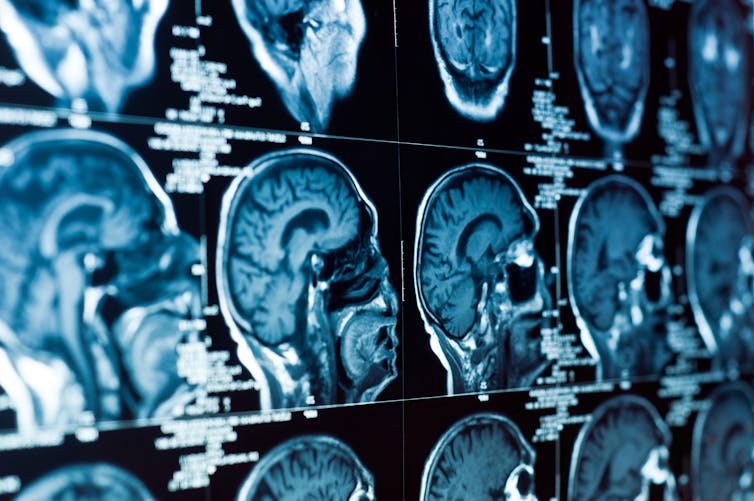The human brain processes the experience of empathy – the ability to understand another person’s pain – in a similar way to the experience of physical pain. This was the finding of a paper that specifically investigated the kind of empathy people feel when they see others in pain – but it could apply to other forms of empathy too. The results raise a number of intriguing questions, such as whether painkillers or brain damage could actually reduce our ability to feel empathy.
The researchers used a complicated experimental set up, which included using functional magnetic resonance imaging (fMRI), which measures blood flow changes in the brain. However, brain imaging alone can’t prove a link between pain and “pain empathy”. This is because the same brain areas are activated in each case, partly because there is a lot of overlap generally between the brain areas used for feelings and emotion. Another factor is that fMRI is not a direct measure of brain activity – the blood flow measure is instead something that we infer to accompany brain activity.

The authors therefore took a new approach. They investigated whether the way a drug changes how the brain processes pain and empathy for those in pain can be used to understand the similarities and differences between these two experiences.
The study is based on two experiments on a total of about 150 participants – which is an unusually large number for this kind of study. The financial expense and general inconvenience of running fMRI studies, means scientists usually just involve some 20 or 30 people.
The painkiller trick
All the participants in the study were given a tablet that they were told was an approved, highly effective, expensive, over-the-counter painkiller (to ensure it had the maximum chance of working). However, none of the participants actually had a real painkiller but a placebo. This effect, called “placebo analgesia”, has been shown to be highly effective at reducing the amount of pain one perceives. However the authors wanted to know whether it affected how pain and pain empathy are processed in the brain.
A second group of people were also given this placebo analgesia, and 15 minutes later a second tablet – a drug that reverses the action of a painkiller. However, the participants were told this tablet would enhance the action of the painkiller, so they weren’t expecting it to counteract any previous drug they were given. The authors wanted to know whether the “placebo analgesia” could be reversed in the same way real painkillers can.
After waiting for the placebo painkiller to “take effect”, and checking that it had “worked” in all people, participants underwent various experiments. These involved receiving a short painful electrical shock to the back of the hand (the strength of this had previously been matched for differences in individual levels of pain threshold – we’ll call this self pain) and watching a picture of someone they had earlier met receive the painful stimulus (we’ll call this pain empathy).
Participants were then split into two groups: some received a real and painful shock (or watched someone receive it), while others received a painless stimuli. The painless stimulus was administered in the same way as the electrical stimulus, but at a lower current.
Participants were asked to rate the amount of pain they felt during self pain and were asked to rate the level of unpleasantness they felt while watching another person receive pain (pain empathy). And they also underwent fMRI during self pain and pain empathy.
The results?
In the first experiment with the one tablet only (placebo painkiller), 53 people received real pain and 49 people received (pretend) pain stimuli. The placebo painkiller reduced the amount of pain the participants reported feeling and also reduced the amount of unpleasantness they reported feeling while watching someone else experience pain. At the same time, the fMRI scan revealed that the network of regions that usually process pain showed a reduction in activity for placebo (pretend) pain compared to real pain.
In the second experiment, where 50 participants took an additional tablet – 25 had the real drug that reverses the action of a painkiller and another 25 people a placebo. The real drug was found to reverse the effects of the placebo analgesia on self pain and also on pain empathy, each by a similar amount. This confirms that the effect of the “pretend” painkiller can be reversed in the same way that a real (drug) painkiller can.

This means that empathy for pain is likely to be processed very similarly (in the brain) to first-hand pain. We can infer that this is because both self pain and pain empathy are changed in the same way by the painkiller-reversing drug, and because placebo analgesia also reduces pain empathy in the same way as it reduces pain. The fMRI results add further evidence that this is indeed what is going on.
Exploring empathy further
This is therefore consistent with the theory that empathy for pain occurs as a result of simulating another person’s feelings within one’s own brain. It also provides further evidence that the feelings of pain and pain empathy occur as a result of similar processes within the brain.
Further, patients who have damage and/or disease in the parts of the brain that fall within this network of pain-processing areas, often experience a reduction in ability to feel empathy for pain. This suggests that the ability to feel pain is necessary in order to experience empathy for pain.
Going forward, the research could be useful to explore empathy in other contexts. For example, the researchers suggest addressing the question of whether the pain from other events – for example social rejection – is processed in a similar way. This study certainly provides a new angle to investigate the feelings of pain and empathy – namely by manipulating two experiences to see if they are processed in similar ways.
Another suggestion is that taking painkillers may decrease one’s feeling of empathy for pain – but that topic needs further research. A way to do this could be to compare the results of this study using placebo painkillers with a similar design using real painkillers.


